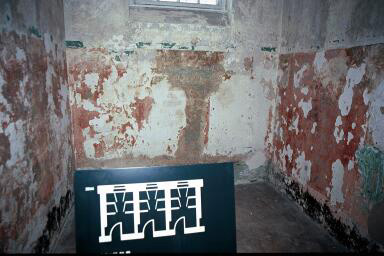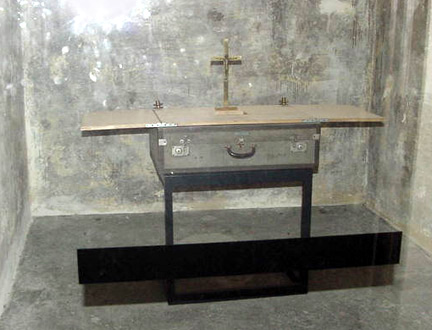Dachau bunker prison cells In 1944, a harsh punishment was devised for prisoners at Dachau when 3 of the regular cells were divided into standing cells. A poster in the photograph above illustrates how this was accomplished. The walls of the standing cells were made out of wood and each standing cell was 2 ft. 6 inches square. Prisoners who had been condemned to this punishment were put into a standing cell for 72 hours at a time with no light or air. Bishop Johannes Neuhäusler, who was a "special prisoner" in the bunker, wrote that "the prisoner was compelled to stand for three days and three nights and was given only bread and water; every fourth day he came into a normal cell, ate prisoner's fare and was allowed to sleep for one night on a plank bed. Then three days' standing began again. Such were the abominations which the prisoners had to bear from the sadistic Nazis." According to information given in the bunker exhibit, the wooden walls of the standing cells were removed by the American Army in 1945 after Dachau was liberated. At his trial before an American Military Tribunal in Dachau, former Commandant Martin Weiss testified in December 1945 that he had no knowledge of the standing cells. He had been the Commandant of Dachau, starting in September 1942, but was transferred on November 1, 1943 to Majdanek. In 1944, Weiss was assigned to be the commander of the Mühldorf sub camp complex of Dachau. In March 1945, Weiss came back to Dachau when the Mühldorf sub camp was evacuated to the main camp. In his testimony, Weiss claimed that he had heard about the standing cells for the first time during his trial. According to information in one of the exhibit rooms, a Soviet prisoner, Yuri Piskunov, was confined to one of the standing cells for 10 days in October 1944, but there is no mention of his crime. He had previously been confined in Mauthausen, but was moved to Dachau in November 1943. Mauthausen was the only Class III camp in the Nazi system; it was for prisoners who were the worst offenders by Nazi standards. Dachau was a class I prison and was considered much more lenient than Mauthausen. Piskunov survived and was still alive when the exhibit opened in 2000.  The Catholic priests were allowed to hold religious services in the "chapel cell" which is near the exit door on the west side of the bunker. The photograph above shows a display in the chapel cell. The small table is a portable altar which was used by the priests to say Mass in the bunker. It is the only artifact in the whole exhibit. According to information in the exhibits, the bunker prisoners were subjected to very harsh punishment. For example, Walter Buzengeiger was imprisoned in total darkness in the old "bunker" between February and October in 1934. He survived and was able to give information on the Dachau prison to the exhibit designers. The following quote from Walter Buzengeiger is projected onto the wall of one of the prison cells in the bunker: Around two o'clock in the morning the key rattles in the lock of the first cell door at the other end of the corridor. We're all awake at once. The unlocked foot-shackle makes a metallic clink on the floor. The prisoner from cell number 1 takes the first few steps into the Bunker courtyard. A shot rings out. A life is extinguished. Walter Buzengeiger, 1 Juli 1934 Some of the bunker cells have the door removed so that visitors can look through the open doorway to see the interior. The cells are quite small with just enough room for a bed and a toilet. Each cell has its own toilet, located in a corner so that a person using it would be shielded from view through the peephole. The toilet is on the right side of the cell door. The photograph below shows one of the toilets in the corner of a cell. Notice the peeling paint on the wall which is in several colors. Other open cells in the bunker show even more colors in the layers of paint on the walls. What appears to be blood on the walls is actually red paint. Each cell in the bunker has an outside window.  In early 1945, "special prisoner" Georg Elser was brought to the Dachau bunker. Two walls were knocked down so that three adjoining cells, numbers 81, 82 and 83 could be made into one cell for him. He was kept isolated from the other prisoners, but was allowed to play his zither and sheet music was supplied to him. Elser was a cabinet maker from Munich who had allegedly tried to kill Hitler with a bomb on the night of November 8,1939. Elser was arrested on November 22, 1939 and incarcerated at the Sachsenhausen concentration camp near Berlin, along with Richard Stevens and Captain S. Payne Best, until he was transferred to Dachau, as the Russian Army approached. Elser had made his assassination attempt by planting a time bomb in a hollowed out column at the Bürgerbräukeller in Munich at a Nazi party meeting. The bomb was set to go off during Hitler's scheduled speech, but Hitler unexpectedly left the hall early and was unharmed. Eight people were killed and over 60 others injured in the blast. Bishop Neuhäusler has much to say about Elser and Captain S. Payne Best in his book which I have quoted on a separate page. According to the Center for Bavarian History, Georg Elser was "murdered" on April 9, 1945 in the Dachau bunker. This was the date of a bombing raid on Munich and Dachau by the US Air force, and the Nazis claimed that Elser had been killed by the bomb. According to Marcus J. Smith, a US military doctor at Dachau after the liberation, who wrote a book called "Dachau: The Harrowing of Hell," there was a bomb shelter at Dachau where the special prisoners were taken when a bomb alarm signal was given. The other prisoners in the bunker were taken to the shelter. The Bunker exhibits do not give any details about the plot to kill Hitler and do not even reveal the connection between Elser, Richard Stevens and Captain Payne-Best. After the liberation, 300 newspaper reporters converged on the camp, drawn by the prospect of a story about the famous prisoners at Dachau, who had been imprisoned in the bunker. The VIP prisoners had all been evacuated to the South Tyrol three days before. One of the honor prisoners at Dachau was Charles Delestraint, a famous French general, who was allegedly executed on April 19, 1945, but I did not see any mention of him in the bunker exhibits. The most famous prisoner, among the German war criminals who were held in the bunker after World War II ended, was Erhard Milch, a Field Marshall who was the number 2 man in the German Air Force. He was brought to the Dachau bunker the day after he testified on behalf of his superior, Hermann Göring, at the Nuremberg trial. Milch was a prisoner at Dachau between 1946 and 1947, but there is no mention of him or any of the other prisoners of the Allies held in the bunker. After the war, the US Army used the SS training camp as a military garrison for 28 years. The bunker was used as a military stockade for American soldiers. PreviousBack to Dachau Concentration CampBack to Table of ContentsHomeThis page was last updated on July 12, 2009 |